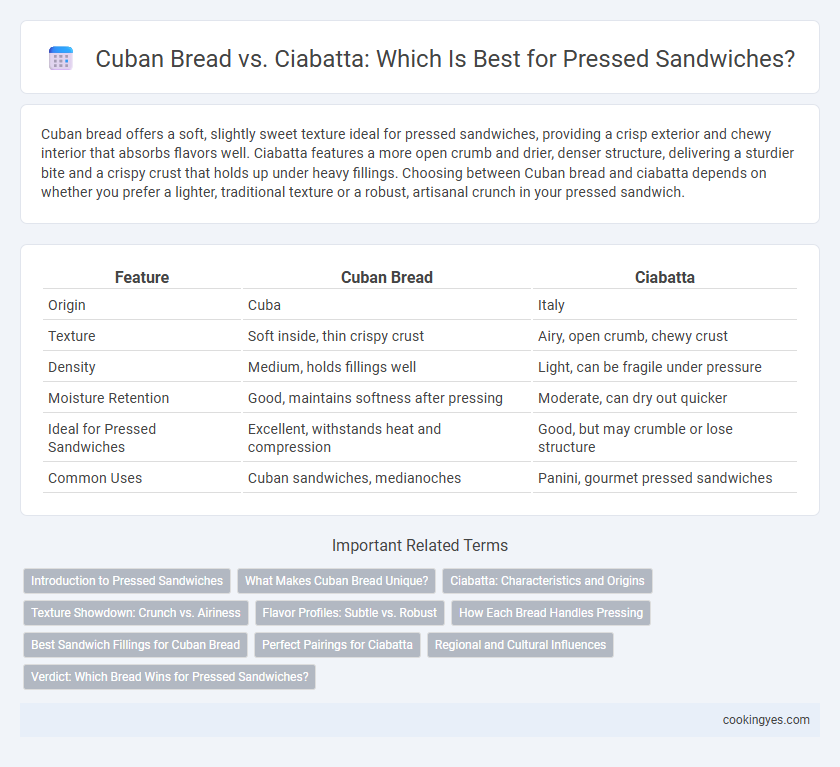Cuban bread offers a soft, slightly sweet texture ideal for pressed sandwiches, providing a crisp exterior and chewy interior that absorbs flavors well. Ciabatta features a more open crumb and drier, denser structure, delivering a sturdier bite and a crispy crust that holds up under heavy fillings. Choosing between Cuban bread and ciabatta depends on whether you prefer a lighter, traditional texture or a robust, artisanal crunch in your pressed sandwich.
Table of Comparison
| Feature | Cuban Bread | Ciabatta |
|---|---|---|
| Origin | Cuba | Italy |
| Texture | Soft inside, thin crispy crust | Airy, open crumb, chewy crust |
| Density | Medium, holds fillings well | Light, can be fragile under pressure |
| Moisture Retention | Good, maintains softness after pressing | Moderate, can dry out quicker |
| Ideal for Pressed Sandwiches | Excellent, withstands heat and compression | Good, but may crumble or lose structure |
| Common Uses | Cuban sandwiches, medianoches | Panini, gourmet pressed sandwiches |
Introduction to Pressed Sandwiches
Cuban bread and ciabatta are popular choices for pressed sandwiches due to their unique textures and flavors. Cuban bread offers a light, airy crumb with a slightly crispy crust that crisps beautifully under heat, while ciabatta provides a denser, chewy texture with large air pockets that hold fillings well. Both breads enhance pressed sandwiches by delivering a satisfying crunch and maintaining structural integrity during grilling.
What Makes Cuban Bread Unique?
Cuban bread stands out in pressed sandwiches due to its distinct texture and composition, featuring a slightly sweet, airy crumb with a thin, crisp crust achieved through a longer fermentation process and the addition of lard or vegetable shortening. Unlike ciabatta's open, porous structure and chewy crust, Cuban bread maintains a balance that absorbs the flavorful pressed sandwich fillings without becoming soggy. This unique combination of softness inside and crispness outside enhances the sandwich's mouthfeel, making it ideal for traditional pressed sandwiches like the Cuban sandwich.
Ciabatta: Characteristics and Origins
Ciabatta is a rustic Italian white bread known for its crispy crust and airy, open crumb, making it ideal for pressed sandwiches that require a sturdy yet tender texture. Originating in the Veneto region in 1982, ciabatta was created as an alternative to French baguettes, emphasizing a soft inside with large holes that absorb condiments without becoming soggy. Its neutral flavor and firm structure help maintain the sandwich's integrity, contrasting with the denser, slightly sweet Cuban bread often used in classic pressed sandwiches.
Texture Showdown: Crunch vs. Airiness
Cuban bread offers a crisp, crunchy exterior with a soft, dense crumb that holds up well under the weight of pressed sandwich ingredients, ensuring a satisfying bite without getting soggy. Ciabatta provides a lighter, airier texture with a porous crumb that absorbs flavors thoroughly but may compress more during pressing, resulting in a less pronounced crunch. Choosing between the two depends on whether a sandwich lover prefers the sturdy, crunchy bite of Cuban bread or the delicate, airy softness of ciabatta for their pressed sandwich experience.
Flavor Profiles: Subtle vs. Robust
Cuban bread offers a subtle flavor profile with a slightly sweet and yeasty taste, complementing pressed sandwiches without overpowering the fillings. Ciabatta presents a robust, earthy flavor with a chewy texture and open crumb, adding a bold character that stands up well to rich, savory ingredients. Choosing Cuban bread enhances delicate flavors, while ciabatta intensifies the overall sandwich experience with its strong, rustic notes.
How Each Bread Handles Pressing
Cuban bread's unique composition, with a slightly denser crumb and thinner crust, allows it to withstand pressing without becoming overly soggy, maintaining a balance between crunch and softness. Ciabatta's airy, open crumb structure absorbs more oil and moisture during pressing, which can result in a softer sandwich but might sacrifice structural integrity. For pressed sandwiches, Cuban bread provides a firmer, more cohesive bite, while ciabatta offers a lighter texture that may require careful handling to avoid collapse.
Best Sandwich Fillings for Cuban Bread
Cuban bread's soft interior and crispy crust make it ideal for pressed sandwiches like the classic Cuban, filled with roasted pork, ham, Swiss cheese, pickles, and mustard. Unlike ciabatta, which has a more open crumb and chewier texture, Cuban bread absorbs flavors while maintaining structure under heat and pressure. Its slight sweetness enhances savory fillings, making it the preferred choice for a perfectly balanced, flavorful pressed sandwich.
Perfect Pairings for Ciabatta
Ciabatta's airy crumb and crisp crust create the perfect texture contrast for pressed sandwiches, allowing fillings like grilled chicken, roasted vegetables, and melted mozzarella to shine. Its mild, slightly tangy flavor complements bold ingredients such as pesto, sun-dried tomatoes, and aged cheeses without overpowering them. This versatile Italian bread elevates pressed sandwiches by maintaining structure while absorbing flavorful oils and sauces.
Regional and Cultural Influences
Cuban bread, with its soft interior and slightly crispy crust, is deeply tied to Cuban-American culture and is essential in authentic Cuban pressed sandwiches like the medianoche and Cubano. Ciabatta, originating from Italy, features an airy crumb and chewy crust that lend a distinct texture and flavor profile favored in Mediterranean-inspired pressed paninis. Regional ingredients and cultural traditions influence the bread choice, making Cuban bread indispensable in Florida's Cuban communities, while ciabatta remains popular in European-style cafes.
Verdict: Which Bread Wins for Pressed Sandwiches?
Cuban bread outperforms ciabatta for pressed sandwiches due to its soft interior and thin, crispy crust that crisps perfectly without overpowering fillings. Ciabatta's porous texture and thicker crust may become too chewy and less pliable, reducing the sandwich's overall balance when pressed. Cuban bread's unique density and slightly sweet flavor create an ideal foundation that maintains structural integrity and complements classic pressed sandwich ingredients like ham, cheese, and pickles.
Cuban bread vs ciabatta for pressed sandwiches Infographic

 cookingyes.com
cookingyes.com